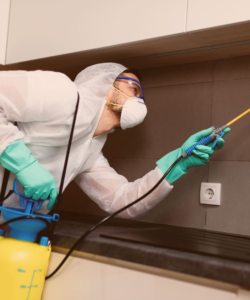Pest Control Bridgewater NJ involves preventing or controlling organisms that damage or destroy crops, plants, or animals. Pests include vertebrates (such as rats, mice, and squirrels), weeds, crawling insects, birds, and diseases such as nematodes and pathogens.
Many plant-eating pests are controlled naturally by predators and parasitic organisms. Mating disruption techniques also reduce pest populations by changing the way they reproduce.

There are more than a million described species of insects, the most diverse group within the arthropod phylum. These hexapod invertebrates have three parts (head, thorax and abdomen), three pairs of jointed legs, compound eyes and a pair of antennae.
Insect pests are major threats to global food security and livelihoods, and can impose significant environmental costs. They destroy crops, undermine trade and contaminate food, harming humans, animals and plants. They also spread diseases such as malaria, cholera, dengue and yellow fever, and contribute to the extinction of many rare and endangered species.
Fortunately, there are countless beneficial insects that use their sharp piercing mouthparts to hunt and devour harmful insect pests, thereby maintaining a balanced ecosystem. From predatory bugs and ladybugs to gall midges and lacewings, these natural predators help control crop pests including whitefly, thrips, caterpillars and leaf miner larvae.
A team led by Laura Harrington, professor of entomology, is developing novel ways to promote the growth of these natural enemies. Her research, which is funded by the New York State Hemlock Initiative, includes manipulating plant scent and humidity to encourage parasitoids to grow. Other work focuses on the complex interplay between the behavior of hawkmoths (a type of moth) and hemlock trees in the Northeast, where these moths are decimating populations.
Researchers around the world are working on various bioengineering techniques to control insect pests with minimal environmental impact. One example is the use of symbiotic microbes to disrupt an insect’s ability to transmit pathogens, dubbed “symbiont-mediated vector control.”
Another approach is genetic modification. Using nuclear transformation and targeted RNA interference, researchers have successfully suppressed Bemisia tabaci genes, a major crop pest, in field trials. However, the high cost of transgenes and limited availability of genetically modified food crops still makes this an unproven technology for commercial application.
Rodents
Rodents are a serious worldwide pest and public health concern, with their pre- and post-harvest losses contributing to global food insecurity and their role as reservoirs of numerous zoonotic diseases that can be transmitted directly or indirectly to humans and other animals. Their high reproductive potential and ability to adapt to new environments makes rodents especially difficult to control.
Unlike insects, rodents are capable of transmitting disease through feces, urine and saliva. They also often carry ticks and lice that can then spread infectious diseases to people. They are also notoriously unsanitary, leaving behind droppings and other material wherever they go.
Rodents are found in almost every habitat on Earth and range in size from pygmy mice, which weigh 4 grams, to capybaras, which can weigh up to 150 pounds. They are distinguished by their incisor teeth, which never stop growing and are optimized for gnawing and chewing. They are also known for their highly developed senses of smell, vision and hearing, and some even have whiskers to help them navigate.
A key factor in successful rodent control is addressing the underlying causes of the problem. For example, removing the shelters and food sources that rodents find attractive can significantly reduce their numbers. This includes eliminating piles of leaves and other debris that provide nesting material for squirrels, rats and mice. It is also important to regularly clean up rodent droppings and other material, and to store food in sealed containers.
Another way to keep rodents from invading a home is to seal any entry points they may use to enter, including cracks and crevices. This can be done by installing caulk or steel wool in any visible areas, and by patching holes inside and outside homes. It is also a good idea to remove anything that rodents might use to chew their way into places they shouldn’t be, like hanging vines or tree limbs touching a building facade.
A well-designed pest management program must address the conditions that encourage rodents and include both physical/mechanical controls and chemical baits or traps. Physical/mechanical control methods include regularly inspecting and cleaning commonly cluttered spaces where rodents are likely to live, such as custodial closets, garages, kitchen drawers, sinks, sill plates, pantry shelves and crawlspaces. Placing nontoxic monitoring bait blocks in tamper-resistant stations and using snap traps, repeating catchall devices and shock traps in inaccessible areas are also helpful.
Bed Bugs
Bed bugs (Cimex lectularius) are elusive insects that do not live outdoors and, as their name suggests, reside mostly in beds and other places where people sleep. They cannot fly or jump, and their small, reddish brown bodies have ridges across the shell and two prominent black eyes, along with an apparatus at the end of their mouth for piercing skin to feed on blood. Their eggs are pearl-white and sticky, allowing them to adhere to almost any surface. Adults lay one to several eggs per day, resulting in hundreds over their lifetime.
Although a reprieve from bed bugs was enjoyed after World War II, they are now common in homes, apartments, hotels, dormitories and schools, as well as in hospitals, theaters, libraries and offices. They even occur on public transportation, where they may be brought in by workers and visitors.
Since they are nomadic and nocturnal, it is possible that a home or apartment can become infested from one source and then spread to other rooms through unnoticed contact. Often, the only sign is a few tiny bites on the torso. Other clues include the odor of crushed bugs and the presence of tiny, dried, dark spots on bedding.
A thorough, professional treatment usually includes systematically spraying all cracks and crevices, especially in bed frames and furniture, where dozens can hide. This includes the areas around electrical sockets and switches, light bulbs, blinds, wallpaper, air vents and smoke detectors. In addition, professionals typically treat seams, folds and creases of mattresses and pillows, as well as upholstered chairs and sofas. Vacuuming alone is not sufficient, and over-the-counter products such as bleach, alcohol, cigarette lighters or “bug bombs” (foggers) should be avoided.
If a suspect pest is identified, the local extension office should be contacted for further identification and control advice. Most items that are heavily infested with bed bugs need to be discarded, but encasement of beds and other furniture in impermeable materials can protect belongings from further infestation and from being spread to other areas. In addition, a careful inspection should be made of surrounding living spaces to find and treat any additional areas of infestation.
Wasps
Wasps and hornets can be a significant nuisance during summer, but they also play an important role in pest control. Many species are predatory, consuming flies, mosquitoes and other pest insects that damage vegetable gardens and ornamentals. Some solitary wasps, such as the cuckoo wasp, are kleptoparasites, parasitizing other insect eggs and adults. Solitary wasps and hornets are also valuable pollinators, helping with fruit and vegetable production. They can also act as deterrents for other insects, especially slugs and snails.
The key to managing wasps and hornets is to minimize direct contact. These insects sting when they feel threatened, including being handled, swatted, or smacked. Stings can be quite painful and in severe cases may trigger a systemic reaction that affects the body’s entire immune system. Repeated stings can even cause liver or kidney problems.
Avoiding direct contact is the best strategy for preventing stings, but this can be challenging when dealing with wasps near picnics or other outdoor activities. Homeowners can help by removing or covering attractants, including sugary drinks and foods, fallen fruit, meat, and scented soaps and shampoos. It is also a good idea to wear long pants and sleeves when working outdoors during warm weather, and to use caution around garbage bins with tight-fitting lids.
Habitat modification can also help reduce wasp populations by trimming back bushes, twigs, and shrubs that could serve as nesting sites. Homeowners can also spray the ground with a commercially prepared, pressurized wasp-killing insecticide, such as resmethrin, permethrin, tetramethrin, cyfluthrin, or DDVP, following all product label directions.
If the wasp problem is widespread or particularly problematic, a professional pest control technician may be required. Some companies offer targeted wasp baits, such as Vespex (fipronil), that can be deployed from a bait station. The bait is a mixture of protein and sugar that lures wasps into the station where it can be administered to kill them and wipe out their nest. Home remedies such as flooding a nest or setting it on fire are not recommended, because they can be dangerous to people and pets.


